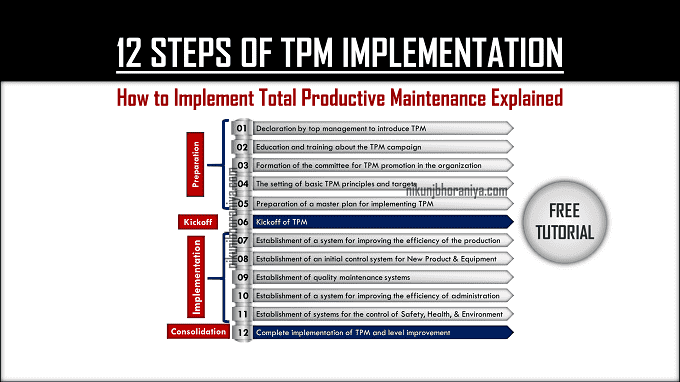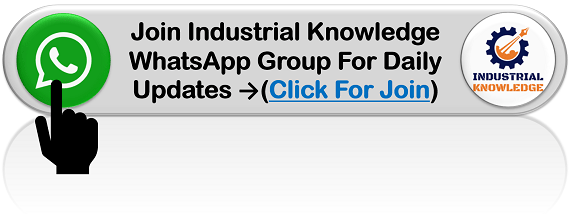How to Implement TPM (Total Productive Maintenance)?
Introduction of TPM
→ TPM stands for "Total Productive Maintenance" and its a strong relationship between Productivity and Maintenance.
→ It tells us about the care of our equipment can give us good productivity.
→ TPM is all about ownership and continual improvement.
→ It empowers the machine operator to maintain and operate the machine in good condition.
→ Total Productive Maintenance helps organizations for Effective and Efficient Productivity.
→ The goal of TPM is zero accidents, zero breakdowns, and zero defects.
→ There is a very tough competition in today's scenario and it is increasing day by day.
→ So customers focus on Product Quality, Delivery Time, and Cost of Product.
→ To fulfill customer's requirements we need to implement various systems at our site also.
→ Refer to this article for Detailed Presentation of Eight Pillars of Total Productive Maintenance.
→ TPM focuses on improve planning and scheduling.
→ Also, focus on different wasteful activities like 16 Major Losses of Production and 6 Big Losses of OEE.
→ Visit this article: 6 Big Losses of OEE that will help us to improve our productivity.
→ Also, visit this article: 16 Major Losses of Production that will help us to improve profitability.
→ Also, refer to this article: Complete Overview of TPM Explained with Complete Details
Benefits of TPM (Total Productive Maintenance)
→ The major benefits are mentioned below:
→ Increase Productivity and OEE (Overall Equipment Efficiency).
→ Reduce customer complaints.
→ Reduce production cost.
→ Increase customer satisfaction by delivering the right Quality Product, at right time with the right cost-benefit of the customer.
→ Reduce accidents.
→ Morale and Motivation improve an employee's attitude change of operator from "We operate you maintain" to "We operate we maintain".
12 Steps of TPM Implementation
→ 12 Steps for Implementation TPM are mentioned below.
- Declaration by top management to introduce TPM
- Education and training about the TPM campaign
- Formation of the committee for TPM promotion in the organization
- The setting of basic TPM principles and targets
- Preparation of a master plan for implementing TPM
- Kickoff of TPM
- Establishment of a system for improving the efficiency of the production
- Establishment of an initial control system for new product and new equipment
- Establishment of quality maintenance systems
- Establishment of a system for improving the efficiency of administration and other departments
- Establishment of systems for the control of safety, health, and the environment
- Complete implementation of TPM and level improvement
Step 1: Declaration by top management to introduce TPM
→ The declaration of the top management about the implementation of TPM in the the organization should be communicated across the organization by a common communication medium.
→ The common communication medium may be notice board, email communication, or internal newsletter.
Step 2: Education and training about the TPM
→ TPM training needs to provide to all employees of the organization.
→ As per the grade and responsibility, the training course needs to design and training should be given.
→ We can give training in any medium like classroom training, virtual training, video lecture, etc.
Step 3: Formation of the committee for TPM promotion in the organization
→ The committees and specialized subcommittees need to be formed for the promotion of the TPM within the organization.
→ The promotion activity can be done with the help of various publications like newsletters, articles, videos, posters, etc.
Step 4: Setting of basic TPM principles and targets
→ Business objectives, benchmarks, and targets need to decide for this improvement journey.
→ As per the current scenarios we need to establish the baseline data for all the organizational KPIs.
→ The setting of SMART goals is: Specific, Measurable, Attainable/Achievable, Realistic, and Time-based.
Step 5: Preparation of a master plan for implementing TPM
→ Prepare the master plan for TPM implementation and also mention the target date and responsibilities.
→ Generally, the time period should be around 3 years but finally, it is decided by the organization.
→ The basis of the master plan, formulate the annual, quarterly, and monthly planning.
Step 6: Kickoff of TPM
→ The top management publically announces the implementation of TPM within the organization.
→ Also communicate the same to various stakeholders like customers, vendors, and various statutory and regulatory bodies.
→ Also, various stakeholders are invited during the kickoff meeting.
→ Total Productive Maintenance implementation activity starts from this step.
Step 7: Establishment of a system for improving the efficiency of the production
→ This step is related to improve the efficiency and effectiveness of the production.
→ For improving productivity and production efficiency we need to implement various 4 pillars of TPM at the production shop floor in this step.
- Kobetsu-Kaizen (Focused Improvement)
- Jishu-Hozen (Autonomous Maintenance)
- Planned Maintenance
- Training & Education Pillar
(A). Implementation of Kobetsu-Kaizen or we can say that Focused Improvement.
→ In these pillars, the project team initiate various activities and workshop of small-group activities that are related to small improvements at production floor.
(B). Implementation of Jishu-Hozen (Autonomous Maintenance) pillars
→ Implement the 7 Step method of Jishu Hozen (Autonomous Maintenance).
→ Develop an autonomous maintenance program for operators.
(C). Implementation of Planned Maintenance pillars
→ Implement the various maintenance practices like corrective maintenance, periodic maintenance, predictive maintenance, etc.
→ Develop a Preventive Maintenance plan for eliminating breakdowns of equipment.
→ It will help us to maintain zero breakdowns.
(D). Implementation of Training & Education Pillar
→ Give train to all team members about the various pillars, skills, and activities.
Step 8: Establishment of an initial control system for new product and new equipment
→ In this step, we need to implement an early equipment management pillar for new product and equipment development.
→ So we can easily get rated output from equipment in a short time period.
Step 9: Establishment of quality maintenance systems
→ In this step, we need to implement the Quality Maintenance pillar.
→ It will help us maintain the zero-defect generation from the machine.
Step 10: Establishment of a system for improving the efficiency of administration
→ In this step, we need to implement the Administration & Officer TPM.
→ This pillar is related to other department's roles for supporting the production department.
Step 11: Establishment of systems for the control of safety, health, and the environment
→ In this step, we need to implement the safety, health, and environment pillar of TPM.
→ This pillar helps to maintain zero accidents.
Step 12: Complete implementation of TPM and level improvement
→ In this step, we should go for the participation of the TPM award.
→ Also, we need to improve our TPM level as per the various levels.
→ Also, we need to take strong targets for next year.





Post a Comment